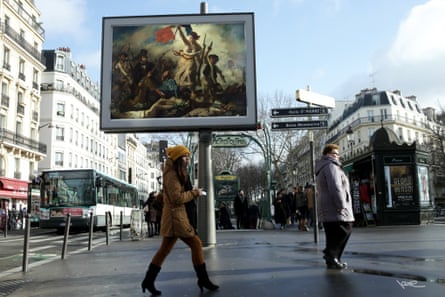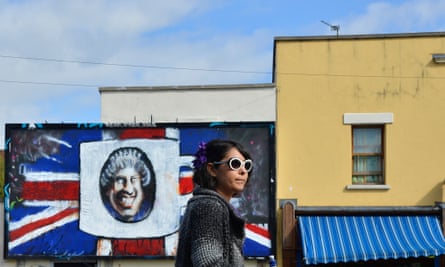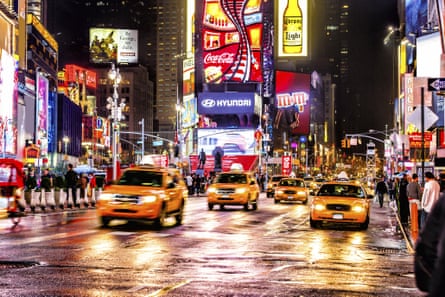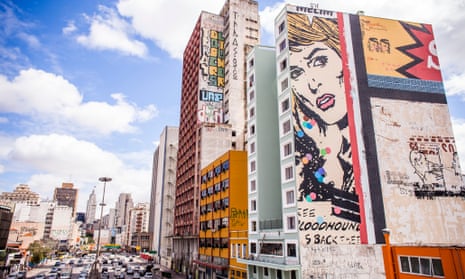Something seemed strange. Staring out of a hotel window in São Paulo, my eye was caught by an oversized digital display crowning the top of an undersized skyscraper. Steadily flashing the time, then the temperature, the display was incongruous in a way that I couldn’t quite put my finger on.
It was only later, when a colleague mentioned that São Paulo had banned billboard advertising, that I realised what had felt so odd about my view. Those flashing numbers were the only visible signage actively making a play for my attention. Having come from New York, I was used to looking out at a landscape of logos and gargantuan product shots; a vista of advertisements all jostling for “eyeballs”, as the industry so charmingly puts it.
Left unchecked, the proliferation of outdoor advertising can consume a city. In the early 2000s, advertising grew exponentially in Brazil, and São Paulo began to suffocate under a smog of signage. Finding it difficult to control the number of ads through regulation, the city took the unprecedented step of banning them altogether. In 2007, Mayor Gilberto Kassab implemented the Clean City Law, labelling outdoor adverts a form of “visual pollution”. In a single year, the city removed 15,000 billboards and 300,000 oversized storefront signs.

It was a small glimpse of things to come. In the last decade, from Bristol to Tehran, there been a global movement to un-brand cities – to rid them, at least partially, of adverts. Citizen vigilantes, artists and activists are playing important roles. Etienne Lavie, for example, has re-imagined what cities would look like if classical paintings replaced adverts; a team of developers in New York has created No Ad, an augmented-reality app that strips the New York City subway of ads, replacing them with art; and in 2008 a group of Bristol citizens petitioned (albeit unsuccessfully) to ban advertising from the city.
But much of the impetus to ban advertising in cities has come from municipalities themselves. In 2009, Chennai, India banned the erection of billboards, and several US states including Vermont, Maine, Hawaii, and Alaska are billboard-free. In 2011, Paris set out plans to reduce the number of ad hoardings by a third. And earlier this year, Tehran replaced all its 1,500 advertising billboards with art for 10 days.
It’s not just about cleansing cities of “visual pollution” as if it were a sort of surface grime. Billboard advertising is far more intimately entwined with the architecture of cities. While in other media we can, to some extent, choose to consume ads, out of home advertising (OOH) has melded itself inextricably into our environment. As Capitol Outdoor writes on its website: “Outdoor advertising… incorporates your targeted branding message into the everyday landscape of commuters and becomes part of the very fabric of the living and working environment where it is placed.”
The ubiquity of outdoor advertising means that we have come to take it for granted; accepting both its presence and its purpose as natural features of the urban environment. “Outdoor ads have become part of people’s day-to-day urban wallpaper… and connect everyday ways of thinking to commercials imperatives,” says Anne Cronin, an advertising and cities expert at the University of Lancaster. This is gleefully echoed by Clear Channel Outdoor, who boast: “When brands advertise on our street structures, they become part of the public social space, entering people’s thoughts and conversations.”
In a recent essay describing the billboard outside her Manhattan apartment, Zadie Smith evokes this intertwining. “Whatever’s on that wall is my view: I look at it more than the sky…. It has a subliminal effect. Last semester it was a spot for high-end vodka, and while I wrangled children into their snowsuits, chock-full of domestic resentment, I’d find myself dreaming of cold martinis… But that was all some time ago. Now the ad says: Find your beach.”

Finding your beach amid an urban jungle doesn’t sound so bad, does it? Might advertising actually add some colour and brightness to cities? The Outdoor Media Centre, a British trade association, certainly thinks so. According to its brochure: “People love outdoor advertising because of the way it entertains and amuses, because it brings a smile to the dreariest of tube journeys between Cockfosters and Piccadilly.”
Piccadilly line commuters and tourists at Times Square notwithstanding, I think it’s safe to say that most people don’t actually love outdoor advertising. Even David Ogilvy, widely considered the father of modern advertising, expressed his disdain for the medium back in 1963. “Man is at his vilest when he erects a billboard,” Ogilvy wrote. “When I retire from Madison Avenue, I am going to start a secret society of masked vigilantes who will travel around the world on silent motor bicycles, chopping down posters at the dark of the moon.”
While Ogilvy never did get that motorbike gang together, the UN has recently revved into the debate. Last year, Farida Shaheed, UN Special Rapporteur in the field of cultural rights, called on member states to be mindful of the influence of commercial advertising and marketing on public space. “The constant bombardment of our senses intrusively impacts our cultural lives,” she says. Outdoor advertising bans are a much-needed step to “re-balance the use of public spaces”.

This means far more than simply tearing down billboards. São Paulo is proof. Nazia Du Bois, who was an advertising executive in São Paulo at the time of the ban, noted that when the ads first came down, the city went through something of an identity crisis. “São Paulo is a pretty ugly concrete jungle, and the lack of outdoor advertising made that hard to ignore,” she says. “It was made particularly unfortunate by the fact that many of the former sites of advertising were simply left bare ... collecting grime over the shadow of what they’d been. That was always a bit sad to see.”
It was also instructive: tearing down ads helped uncover previously hidden inequality within the city, exposing favelas that had previously been blocked by billboards. Without the perma-glow of advertising, people were forced to confront public space in a new light.
The latest and perhaps boldest attempt to un-brand public space comes from Grenoble, France, which last year became the first city in Europe to ban commercial street advertising. The mayor’s office stated that it was “taking the choice of freeing public space in Grenoble from advertising to develop areas for public expression” and replaced 326 advertising signs with community noticeboards and trees.
All this sounds rather bucolic, but the Grenoblians I spoke to about the ban seemed underwhelmed by the move; they hadn’t noticed a big change in the city. This may have something to do with the fact that, despite the billboard ban, Grenoble hasn’t actually entirely rid itself of advertising; the city’s bus and tram stops will continue to be financed by advertising until the contract with JCDecaux runs out in 2019.
This lingering transit contract is symbolic of a wider Faustian pact between advertising and cities. Advertising helps to fund some city infrastructure – such as the proposed new free WiFi booths in New York City – and in return, it insinuates itself semi-permanently into the environment. Entirely ridding a city of its advertising and truly rebalancing public space is a long process of untangling public infrastructure from private interests.
It’s an expensive proposition, too. The outdoor advertising companies would have you believe that cities can’t actually afford to buy back their public space; that without their patronage, public infrastructure will become an enormous tax burden or fall apart. Advertising is, indeed, an important source of revenue for many cities. In the UK, cuts to public funding have made some local councils heavily reliant on it. Between 2010 and 2016, the government will have cut Islington council’s funding in half. James Murray, executive member for housing development in Islington, notes that the enormous cuts have forced the council to seek new revenue – and advertising is an important stream.
Grenoble, for its part, says it can balance its books sans billboards. The Mayor’s office claims that, although it used to earn £470,000 a year from street ads, this was expected to drop to around £105,000 in 2015 because of a slump in advertising rates. The city says it has already made up for lost revenue by cutting entertainment expenses and councillors’ allowances.

Whether these figures, representing around an 80% slump in ad rates, are entirely accurate is up for debate. In a statement regretting Grenoble’s ban on billboards, JCDecaux rather slyly mentions that Grenoble has one of the highest vandalism rates in France – “including the breakage of over 1,000 glass bus shelter panels in some years, which JCDecaux replaces free of charge”. The company adds that it is confident Grenoble will eventually be enticed back to advertising ... by pointing to São Paulo.
São Paulo, you see, is not exactly an ad-free city any longer. Five years after the Clean City Law, it has begun to gradually reintroduce advertising in a controlled manner. Rather than being plastered haphazardly on billboards, ads have crept more methodically into the city’s infrastructure. “[The advertising] is much more organised now,” says Janaína Silva, a communications professional in São Paulo. “Some bus stops have interactive panels so you can Google search, see the weather forecast... they are pretty useful.”
JCDecaux also has a 25-year advertising clock contract in São Paulo, meaning the company is responsible for the design, maintenance and marketing of advertising faces on 1,000 digital clocks – perhaps even the clock I looked out on from my hotel window, ad-free for who knows how long?
Though OOH firms are worried – a 2015 Pwc media outlook predicts that stricter regulation will be a growing industry challenge, as more blanket bans on billboards are enacted – the movement ultimately does little to rid commercial interests from our public spaces. Billboard ad bans may result in fewer garish signs jostling for “eyeballs”, but brands are finding new ways to insinuate themselves into the fabric of our lives and jostle for brain cells. Not only are we presented with ads on our smartphones now, but in London you might have found yourself being tracked by technology hidden in a recycling bin, allowing advertisers to send personalised messages to your phone. Meanwhile Uber might be handing over your data to a city in exchange for more favourable regulation. And then there is the relentless rise of privately owned public spaces.
When technology means that ads can exist anywhere, billboards represent the tiny tip of a corporate iceberg. How we move beyond superficial advertising bans to deal with this deeper challenge, only (JCDecaux-funded) time will tell.
Follow Guardian Cities on Twitter and Facebook and join the discussion

Comments (…)
Sign in or create your Guardian account to join the discussion